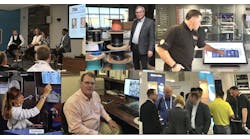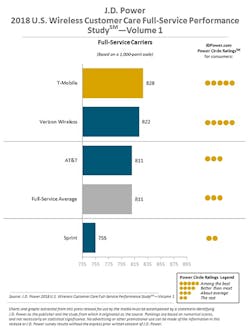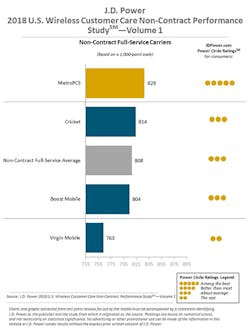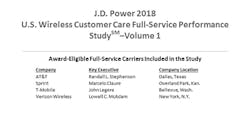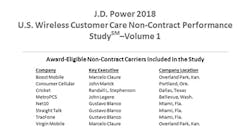Latest from Professional Development/Leadership
Social Media Emerges as Wireless Customer Service Channel of Choice
Could social media be realizing its true calling as the ultimate customer service channel?
According to the J.D. Power 2018 U.S. Wireless Customer Care Full-Service Performance Study — Volume 1 and the J.D. Power 2018 U.S. Wireless Customer Care Non-Contract Performance Study — Volume 1, overall satisfaction is highest when customers ask questions or make requests of their wireless carriers via social media.
"Personalized feedback, rapid-fire response time and interaction with live humans are some of the primary factors driving the highest levels of customer satisfaction with wireless carrier customer service and, increasingly, customers appear to be finding that formula through alternative channels such as social media," said Peter Cunningham, Technology, Media, and Telecommunications Practice Lead at J.D. Power. "That doesn’t mean call centers and brick-and-mortar stores are no longer relevant; in fact, personalized assistance via phone, app and face-to-face are still critical to customer satisfaction."
Following are key findings of the 2018 studies:
• Social channels become front line for customer service
Among customers who ask a question or make a request of their wireless carrier, overall satisfaction is highest in the social media channel (838 on a 1,000-point scale) and the app channel (835). By contrast, overall satisfaction scores average just 797 among customers who handle these requests on the phone with a representative.
• The human touch still matters
Satisfaction tends to be much higher when customers use a channel that provides personalized feedback. For example, assisted care satisfaction is 26 points higher than unassisted care satisfaction (819 vs. 793, respectively), and satisfaction is 824 among customers who ask their question in the store channel vs. 797 among those who speak with a rep over the phone. Additionally, among customers who ask a question or make a request through their carrier’s app, overall satisfaction is 845 when they think they are interacting with an actual person vs. 800 when they think the system is automated.
• Video plays a key role
The channels with the highest first-contact resolution incidences are online videos (92%) and mobile app to research information (90%). Among customers who view an online video from their wireless carrier, 34% say they "definitely will not" switch to a new carrier in the next 12 months vs. 21% among those who use the phone automated response system.
• Not-so-immediate gratification via email
While social, app-based and face-to-face customer support are prized by consumers for their personalized, rapid response, the average customer service response time via email is 32 hours.
Study Rankings
For full-service carriers:
1. T-Mobile ranks highest with a score of 828
2. Verizon Wireless (822) ranks second
3. AT&T (811) ranks third
The full-service segment average is 811.
For non-contract full-service carriers:
1. MetroPCS ranks highest with a score of 828
2. Cricket (814) ranks second
3. Boost Mobile (804) ranks third
The segment average is 808.
For non-contract value carriers:
1. Consumer Cellular ranks highest with a score of 880
2. Straight Talk (770) ranks second
3. Net10 (760) ranks third
The segment average is 779.
The 2018 U.S. Wireless Customer Care Full-Service Performance Study — Volume 1 and the 2018 U.S. Wireless Customer Care Non-Contract Performance Study — Volume 1 are redesigned this year to provide deeper insight into assisted care and unassisted care customer service channels. This allows a deeper understanding of customer interaction across 12 different customer service channels:
1. Phone customer service reps
2. In-store contact
3. Online chat
4. Email
5. Social media post
6. Carrier app question post
7. Automated telephone systems
8. Website search
9. Social media search
10. User forum
11. Video from carrier
12. Carrier app search
Both studies collectively surveyed 15,668 customers who contacted their carrier’s customer care department within the past 3 months. The studies were fielded from July through December 2017.
For more information about the U.S. Wireless Customer Care Performance Studies, visit http://www.jdpower.com/resource/us-wireless-customer-care-performance-study.
About the Corporate Author: J.D. Power is a global leader in consumer insights, advisory services and data and analytics. These capabilities enable J.D. Power to help its clients drive customer satisfaction, growth and profitability. Established in 1968, J.D. Power is headquartered in Costa Mesa, Calif., and has offices serving North/South America, Asia Pacific and Europe. J.D. Power is a portfolio company of XIO Group, a global alternative investments and private equity firm headquartered in London, and is led by its 4 founders: Athene Li, Joseph Pacini, Murphy Qiao and Carsten Geyer.
